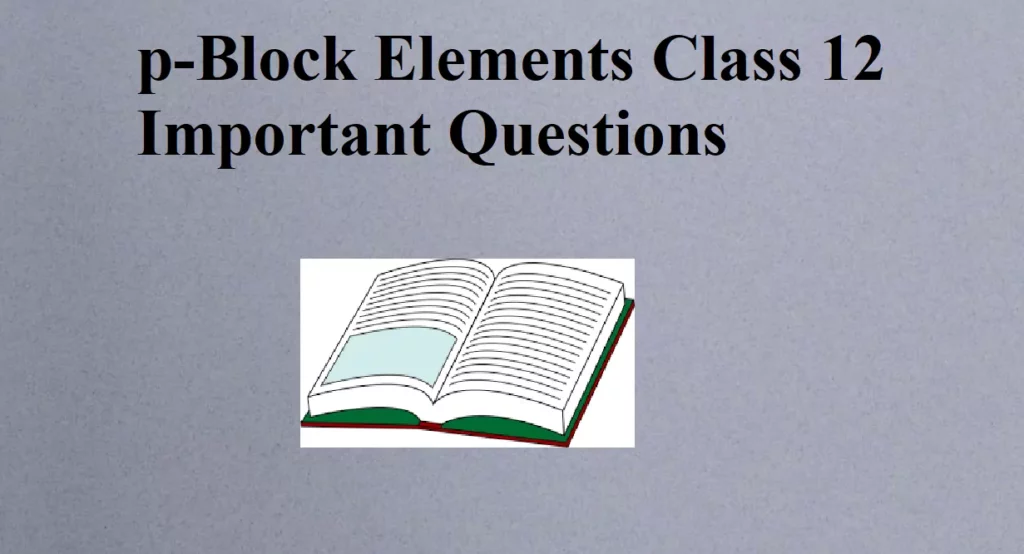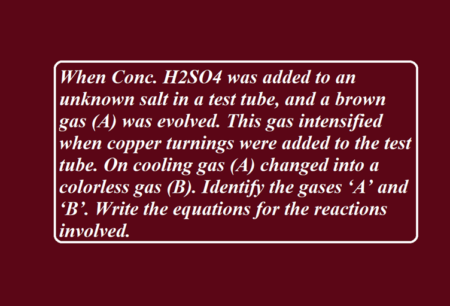p-Block Elements Class 12 Important Questions
Que 1. Sulphur has more tendency to show catenation than oxygen. Explain.
Ans 1. Due to the stronger S‐S bond and due to small size and greater inter electronic repulsion O‐O bond is weakened so it can’t show catenation.
Que 2. Why nitric oxide becomes brown when released into the air?
Ans 2. Nitric oxide becomes brown when released into the air due to the formation of Nitrogen Dioxide (NO2)
2 NO + O2 → 2 NO2
Colourless Brown
Que 3. Explain why SF4 is easily hydrolysed, whereas SF6 is resistant to hydrolysis?
Ans 3. SF4 is easily hydrolysed whereas SF6 is not easily hydrolysed because the S atom in SF4 is not sterically protected as it is surrounded by only four F atoms, so the attack of water molecules can take place easily. In SF6 the S atom is protected by 6 F atoms.
Que 4. The ionisation enthalpy of the group 15 elements is greater than that of group 16 elements in the corresponding periods.
Ans 4. Group 16 elements have a lower value of first ionization enthalpy as compared to group 15 elements. As group 15 elements have half-filled p-orbital due to which group 15 have got extra stability.
Que 5. Oxygen is gas but sulphur is solid. Explain.
Ans 5. Due to its small size oxygen makes pΠ ‐ pΠ bond and exists as O = O. That is why oxygen is gas but sulphur is bigger in size and can’t make Pπ‐Pπ bond so exists as polymeric form.
p-Block Elements Class 12 Important Questions
Que 6. Nitrogen shows little tendency of catenation.
Ans 6. Due to the smaller size, the lone pairs of electrons on the two N-atoms repel the bond pair of N-N bond. Consequently, nitrogen shows little tendency for catenation.
Que 7. In group 16, the stability of the +6 oxidation state decreases and that of the +4 oxidation state increases down the group. Why?
Ans 7. Because of the inert pair effect, inner 2s electrons will not involve in any bond formation.
Que 8. NH3 is basic while BiH3 is only feebly basic.
Ans 8. NH3 is basic while BiH3 is feebly basic. Nitrogen has a small size due to which the lone pair of electrons are concentrated in a small region. This means that the charge density per unit volume is high. This result in an increase in repulsion between electrons and hence lone pair electrons of N are available for donation easily.
Que 9. H2S is more acidic than H2O why?
Ans 9. Bond dissociation enthalpy of S‐H bond is lesser than O‐H bond due to the bigger size of sulphur.
Que 10. What are Interhalogen compounds?
Ans 10. A compound formed between two different halogen atoms called the Interhalogen compound. It is of type XX’.
p-Block Elements Class 12 Important Questions
Que 11. What happens when sulphur dioxide gas is passed through an aqueous solution of a Fe(III) salt?
Ans 11. It converts Fe3+ ions to Fe2+ ions.
2 Fe3+ + SO2 + 2 H2O → 2Fe2+ + SO42– + 4 H+
Que 12. The HNH angle value is higher than HPH, HAsH, and HSbH angles. Why?
Ans 12. As we move down the group, the atomic sizes increase and the electronegativity decrease. As a result, there is a gradual decrease in the electron density of the central atom. This causes greater repulsion between the electron pairs which are around nitrogen, resulting in maximum bond angle Thus, the HNH angle value is higher than HPH, HAs H and HSbH angles.
Que 13. OF6 compound is not known, why?
Ans 13. Due to the absence of d‐orbital in oxygen, it is unable to form OF6.
Que 14. Discuss the occurrence of nitrogen and phosphorus.
Ans 14. Nitrogen → N2 gas, proteins in plants and animals, NaNO3, KNO3
Phosphorus → Bones, living cell, minerals of apatite family e.g., fluorapatite.
Que 15. All the bonds in SF4 are not equivalent. Why?
Ans 15. SF4 has four bonded atoms and one lone pair. The five electron pairs around sulphur adopt trigonal bipyramidal geometry in which one position is occupied by a lone pair. This lone pair finds a position that minimizes the number of 90o repulsions it has with bonding electron pairs. It occupies an equatorial position with two 90o repulsions. The bonded electrons occupy the axial and equatorial positions. The axial S-F bonds are bent slightly away from the lone pair. Hence, all the bonds in SF4 are not equivalent.

p-Block Elements Class 12 Important Questions
Que 16. Draw the structure of H2S2O8.
Ans 16.

Que 17. Write the important points to show anomalous behaviour of nitrogen in group 15.
Ans 17. (i) Nitrogen is a diatomic molecule and inert.
(ii) It shows a weaker catenation tendency.
(iii) Maximum covalence of 4 only
(iv) Forms pπ-pπ bond.
Que 18. Ka2 << Ka1 for H2SO4 in water, why?
Ans 18. H2SO4 (aq) + H2O (l) → H3O+ (aq) + HSO4− (aq) Ka1 > 10
HSO4− (aq) + H2O (l) → H3O+ (aq) + SO4−2 (aq) Ka2 = 10−2
Ka2 is less than Ka1 because HSO4− ion has much less tendency to donate a proton.
Que 19. Ammonia (NH3) has a higher boiling point than Phosphine (PH3).
Ans 19. Nitrogen is more electronegative as compared to phosphorous, hence ammonia is capable of forming hydrogen bonding whereas phosphine cannot form hydrogen bonding. Due to hydrogen bonding has a much greater boiling point than phosphine.
Que 20. Explain why:
a) SF6 is kinetically an inert substance or SF6 does not hydrolyse easily.
b) H2O is liquid while H2S is a gas.
Ans 20. a). SF6 is chemically inert due to the reason that the six F atoms protect the sulphur atom from attack by the reagents to such an extent that even thermodynamically most favourable reactions like hydrolysis do not occur.

b). H2O is liquid due to intermolecular H‐ bonding which is not available in H2S.
p-Block Elements Class 12 Important Questions
Que 21. How is phosphine prepared from white phosphorus?
Ans 21. P4 + 3 NaOH + 3 H2O → PH3 + 3 NaH2PO2.
When pure it is non-inflammable but explodes in presence of P2H4 or Cl2. It is colourless. Used in Holme’s signal, a smokescreen.
Que 22. Dioxygen O2 is a gas while sulphur (S8) is solid. Why?
Ans 22. Because oxygen is smaller in size hence have the capacity to form pπ–pπ multiple bonds, exists as dioxygen (O2), whereas due to bigger size sulphur does not form multiple bonds and exist as S8.
Que 23. Explain why:
(i) Nitrogen does not form pentahalides.
(ii) Helium is used for filling weather balloons.
(iii) ICI is more reactive than I2.
Ans 23. (i) Nitrogen does not form pentahalides because it has no vacant d-orbitals in its valence shell.
(ii) This is because it is lighter than air.
(iii) This is because ICl is polar and has lower bond energy than I2 (non-polar).
Que 24. Sulphur in vapour state exhibits paramagnetic behaviour. Why?
Ans 24. S2 contains unpaired electrons in antibonding M.O just like O2 molecule {(σ1s)2 (σ∗1s)2 (σ2s)2 (σ∗2s)2 (σ2px)2 (π2py2,π2pz2) (π∗2py1,π∗2pz1)}.
Que 25. In the preparation of H2SO4 by contact process, why is SO3 not absorbed directly in water to form H2SO4?
Ans 25. Because it forms a dense fog of sulphuric acid which does not condense easily.
p-Block Elements Class 12 Important Questions



